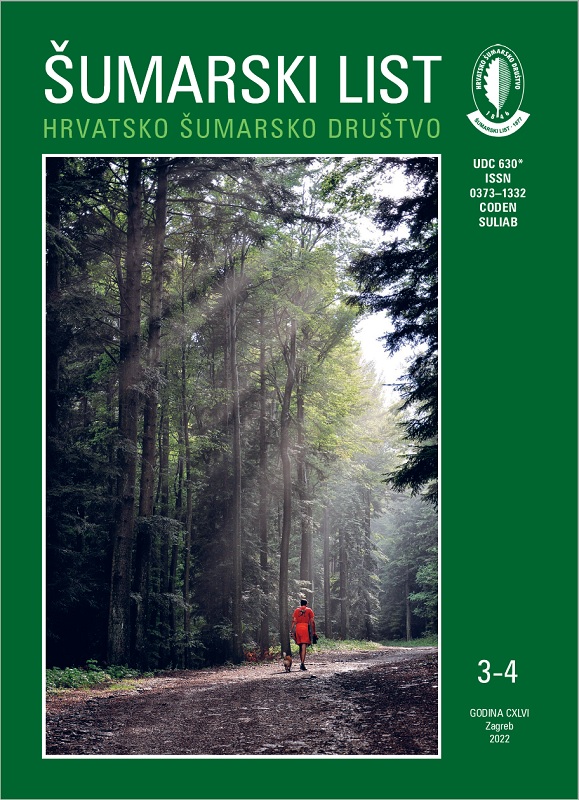
broj: 3-4/2022
pdf (12,34 MB) |
|
||||||||||||||
| RIJEČ UREDNIŠTVA | ||
| Uredništvo | ||
| Do we use biomass as an energy source? If so, how do we use it? pdf HR EN | 101 | |
| IZVORNI ZNANSTVENI ČLANCI | ||
| David Janeš, Andreja Đuka, Ivica Papa, Tibor Pentek, Maja Moro, Ivan Žarković, Tomislav Poršinsky | UDK 630* 686 + 463 (001) https://doi.org/10.31298/sl.146.3-4.1 | |
| Indicators of primary forest accessibility in different terrain categories pdf HR EN | 103 | |
| Kristijan Tomljanović, Marijan Grubešić, Danko Diminić, Milan Poljak, Jelena Kranjec Orlović | UDK 630* 156 + 451 (001) https://doi.org/10.31298/sl.146.3-4.2 | |
| Red deer (Cervus elaphus L.) damage on stands of narrow-leaved ash (Fraxinus angustifolia Vahl) of Middle Posavina pdf HR EN | 117 | |
| Mustafa Arslan, Arzu Ucar Turker, Isa Tas, Arzu Birinci Yildirim, Erva Ozkan | UDK 630* 423 (001) https://doi.org/10.31298/sl.146.3-4.3 | |
| Determination of some phenolic substances in six different populations of turkish hazel (Corylus colurna L.) leaves and comparison of phenolic fluctuation with water deficiency pdf HR EN | 127 | |
| Summary Turkish hazel (Corylus colurna L.) is one of the naturally grown hazelnut species in Turkey. It can be easily separated from other hazel species with its thick single stem and tall appearance. It can be used in afforestation and erosion control studies due to low demand for habitat and strong root system. It contains substances with high medicinal value in its fruits and leaves. Hazel leaves have strong antioxidant activity due to their high phenolic content. Objective of the study was primarily to determine the individual phenolic constituents of six different population of Turkish Hazelnut and then to evaluate the effect of water deficiency stress generated by irrigation regime on phenolic constituents and photosystem II activity on these genotypes. Grafted plants were produced by taking scions from six different populations of Turkish Hazelnut (Oğuzlar, Erenler, Merkeşler, Seben, Güney Felakettin and Pelitcik). The study was started when the grafted seedlings were 7 years old in greenhouse. During the experiment (June and July), two different levels of irrigation were applied (W1: the soil was fully irrigated to reach field capacity in each irrigation; W2: 50% reduction of W1 irrigation water). After the application of two different irrigation regimes, leaves were collected for each month, dried, extracted with methanol and then quantitatively analyzed and compared for individual phenolic constituents (gallic acid monohydrate, caffeic acid, rutin hydrate, luteolin-7-O-β-D glucoside, kaempferol, rosmarinic acid, myricetin, quercetin, coumarin and apigenin) by using high performance liquid chromatography (HPLC) coupled with a diode array detector (DAD). Generally, rutin, kaempferol and luteolin were dominant individual phenols in methanol extracts of Turkish hazelnut leaves. Pelitcik population was noticeable source of rutin and kaempferol in June, and the halved irrigation regime significantly increased the levels of both phenols in July. Similarly, the highest total phenolic content was observed in the Pelitcik population in June and the halved irrigation regime significantly increased the total phenolic content in both months in this population. It was also determined to what extent water deficiency physiologically affects the quantum efficiency (Fv/Fm) of photosystem II activity through chlorophyll fluorescence technique in hazelnut leaves. Generally, Fv/Fm value decreased with water deficiency. This study showed that water deficiency stress generally caused an increase in phenolic constituents in Turkish Hazel leaves and they may be proper natural sources of phenolic constituents with abiotic stress applications in pharmaceutical and food industry. Key words: Corylus colurna L.; quantum efficiency; phenol; Turkish Hazelnut; water deficiency | ||
| Ender Bugday | UDK 630* 261 (001) https://doi.org/10.31298/sl.146.3-4.4 | |
| A GIS based landslide susceptibility mapping using machine learning and alternative forest road routes assessment in protection forests pdf HR EN | 137 | |
| PRETHODNO PRIOPĆENJE | ||
| Zdravko Dolenec | UDK 630* 148.2 https://doi.org./10.31298/sl.146.3-4.5 | |
| Dates of arrival of the Eurasian golden oriole (Oriolus oriolus L.) in decidious forest in relation to increase of local air temperature in NW Croatia pdf HR EN | 149 | |
| PREGLEDNI ČLANCI | ||
| Matija Bakarić, Ivan Martinić, Mario Šporčić, David Mijoč, Matija Landekić | UDK 630* 641 https://doi.org/10.31298/sl.146.3-4.6 | |
| Entrepreneurial infrastructure and entrepreneurship in forestry of Croatia – possibilities and perspectives pdf HR EN | 153 | |


